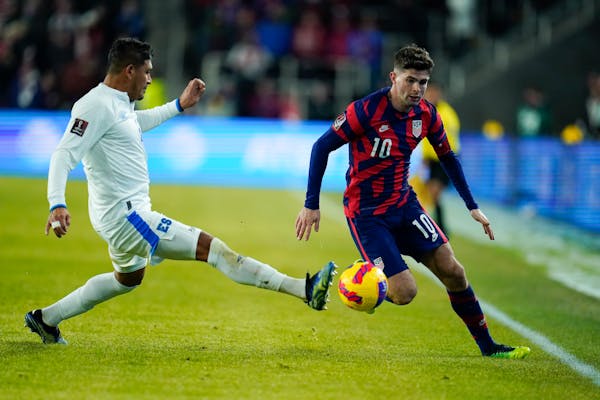Be it ever so humble, there's no place like a home FIFA World Cup qualifier.
At least not in a CONCACAF region where member countries from Mexico into Central America and the Caribbean use heat and humidity, altitude, air quality and, in normal times, fervent fans to their advantage.
Here in pandemic-modified times, the U.S. men's national team plays its third qualifier within a week — this one likely in single-digit temperatures Wednesday night at Allianz Field against Honduras.
Soccer outdoors, in Minnesota, in winter's midst?
Why?
In 2018, the U.S. didn't qualify for the World Cup for the first time since 1986. It didn't partly because of a damaging 2-0 summertime qualifying loss in New Jersey that presumably drew too many or just too loud Costa Rica supporters.
In this three-game qualifying window played unusually in mid-winter because of COVID delays, the Americans are playing their two home games in northern cities against tropical teams far from either U.S. coast's population centers.
They beat El Salvador 1-0 on Thursday night in Columbus, Ohio. In between home games, the U.S. plays at Canada on Sunday in Hamilton, Ontario.
All of it is intended to provide a home-country edge in both support and weather.
Both U.S. home games were scheduled in intimate, soccer-specific stadiums. Home to Minnesota United, Allianz Field's capacity is 19,400, Columbus' new Lower.com Field's capacity is 20,371.
"Great stadiums and great atmosphere provide a huge advantage to our team," U.S. coach Gregg Berhalter said.
Berhalter called Thursday's fans and field "fantastic" and a snow-free, 31-degree night "optimal."
Canada used the same tactic in November, when it brought mighty Mexico to cold Edmonton and players celebrated their victory by tumbling into sideline snowbanks.
An underground heating element warms the Allianz Field grass field to 55-plus degrees, but not players, coaches, staff and fans, except those in club seating.
"You know what? I want it to be freezing," U.S. defender Walker Zimmerman said. "I want it to be cold. I want the snow. I want to be part of something so iconic that I saw and really remember growing up. That's exciting to me. I think the guys are really ready to embrace it."
You know what they say about being careful what you ask for?
Out in the cold
The U.S. is second in its eight-team group, one point behind Canada and one ahead of Mexico in qualifying that ends in March, The top three teams move on to the 2022 World Cup in Qatar come November.
The Americans have played cold home World Cup qualifiers before, including a 2-0 victory over Mexico in Columbus in February 2001. And who could forget the March 2013 "Snowclasico" that Zimmerman remembers vividly — a 1-0 U.S. victory played in a snowstorm in Denver?
The temperature was 29 degrees at kickoff in both games.
That will seem balmy compared to Wednesday's game-time temps.
"They're all coming from the equator, and it's going to be really difficult for them to deal with these conditions," Berhalter said. "They're going to take a couple of breaths and it's going to hit them like it never hit them before."
Wednesday's kickoff could feel like 5 below zero with the windchill factored. There's little chance of snow, but a cold snap Wednesday could bring a 9-degree high and a 10-mph northerly wind.
That forecast would reach "extreme conditions" under safety guidelines U.S. Soccer published in 2015. That black alert level recommends cancellation or rescheduling indoors because of frostbite threat.
Earlier this month, 38,000 bundled fans attended the NHL's Winter Classic at Target Field. St. Louis trainers filled their goaltender's water bottle with steaming chicken broth to prevent freezing when the air temperature reached minus-10 degrees.
U.S. Soccer will take special measures: All spectators — as many as 20,000 — will receive free disposable handwarmers. Additional hot drink and food items will be available at concession stands. Medical stations will be added and medical teams will rove the stadium as well.
Allianz Field head groundskeeper Ryan Moy researched weather data for Feb. 2 the past six years, finding the warmest was 46 degrees in 2020 and the lowest 12 in 2018. Monday's forecast high is 32 degrees, but single digits by Wednesday.
"It could be anything," he said in November.
Looks like, of course, it's going to be cold. It's Minnesota.
'Mind over matter'
Moy's crew used tarps, underground heating and large, wheeled "grow lights" to turn a field dormant in December to one awakened for a midwinter game.
USMNT representatives consulted Wild officials about their Winter Classic experience and have been in conversations with the grounds crew for months.
Berhalter calls playing in the cold "mind over matter," although he might not know the significant difference between Columbus cold and Minnesota cold. He said he wore short sleeves when he played professionally in Germany in single-digit temperatures.
"Cold is a mind-set," Berhalter said. "It really is."
Tell that to St. Paul's own Tony Sanneh, the former Minnesota Thunder, MLS and U.S. national team player who now runs his own St. Paul youth foundation. He played in that 2001 game against Mexico.
"I was like an idiot, like I was going to be a tough guy," said Sanneh, who is Wednesday's game ambassador. "So I wore just a short-sleeve shirt and no gloves. It was a mistake."
El Salvador players wore leggings or high socks Thursday. Some Americans wore shorts, some covered their legs. Most players from both sides wore long-sleeve shirts underneath their jerseys.
"I'm sure the Americans will be good for it, I'm not sure about the Hondurans," said Minnesota United coach Adrian Heath, an Englishman who has coached here indoors and out since 2017. "The reason it is here is because it's so unfamiliar to them. If it's cold, put some gloves on, put some tights on and they'll be fine."
Minnesota United's Twitter account offered this advice when the game was announced in November:
"Long underwear & hot toddies, friends."
